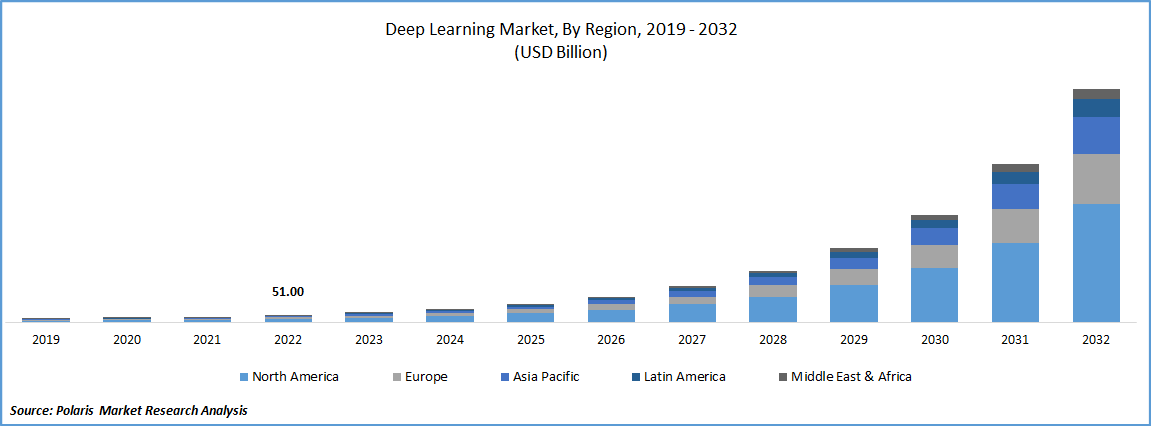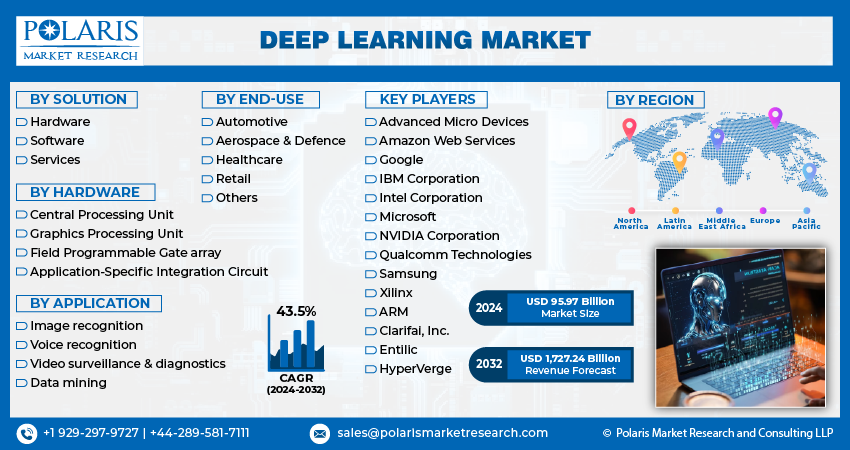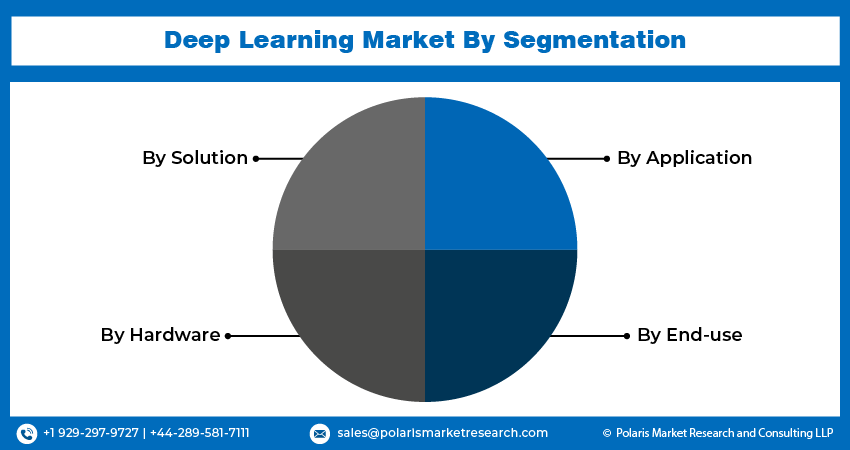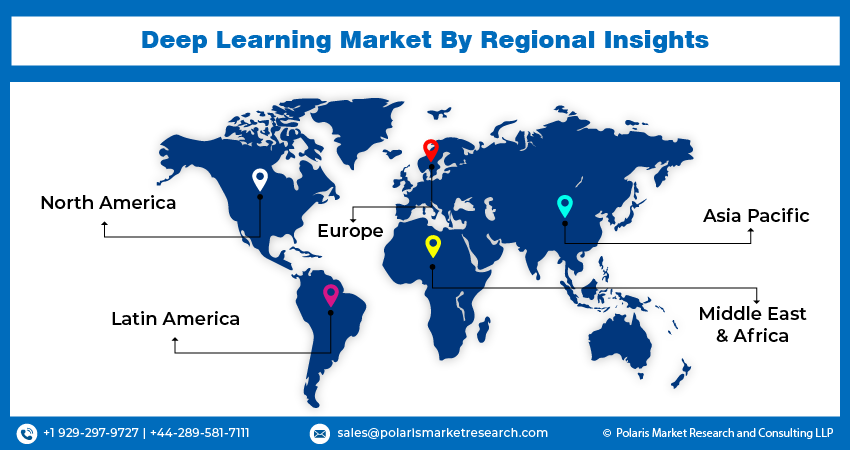
Deep Learning Market Share, Size, Trends, Industry Analysis Report
By Solution; By Hardware; By Application (Image Recognition, Voice Recognition); By End-use; By Region; Segment Forecast, 2023- 2032
- Published Date:Jan-2024
- Pages: 116
- Format: PDF
- Report ID: PM3335
- Base Year: 2023
- Historical Data: 2019-2022
Report Outlook
The global deep learning market size and share was valued at USD 69.64 billion in 2023 and is expected to grow at a CAGR of 43.5% during the forecast period.
The popularity of this industry is experiencing a sudden rise because of the improvements made in data center capabilities and computing power. This technology can complete tasks without human involvement, which has resulted in more cost-effective and efficient solutions. In recent times, cloud-based services and the creation of unstructured data have raised the demand for deep learning solutions. Big data analytics and the need to enhance computing power have also led to high adoption rates in various sectors. For instance, In April 2021, IBM introduced its latest offering, the IBM Watson Orchestrate platform, a cutting-edge platform that harnesses the power of natural language processing and machine learning to automate various tasks and workflows. This innovative platform is designed to help organizations achieve increased productivity and operational efficiency by automating manual, repetitive tasks.
Deep learning is a subset of machine learning concerned with algorithms imitating the way humans gain specific types of knowledge. It’s capable of learning complex patterns and relationships within large datasets. Deep learning can recognize patterns from various data types, such as pictures, sounds, and texts. The patterns are then used to produce accurate insights and predictions. It has garnered significant traction in the past few years, owing to the rise in computing power and the availability of large datasets.
Deep learning is basically a neural network having three or more layers. These layers are the input layer, hidden layers, and the output layer. The input layer receives data from the outside world, whereas the hidden layers have the function of processing and transporting data to other layers. The final result or prediction is made in the output layer. Deep learning has a wide range of applications in several sectors. They’re used in self-driving cars, defense systems, and medical image analysis. Besides, deep learning solutions offered by deep learning market key players are used in manufacturing facilities to detect people or objects that are within unsafe distances between machines.

To Understand More About this Research: Request a Free Sample Report
Moreover, the development of humanoid robots and the growing applications of deep learning in machine translation, data mining, and language translations have significantly contributed to the expansion of the global market. The increasing adoption of deep learning technology in industries like automotive, has also contributed to the growth of the market. Deep learning has been shown to improve the accuracy and efficiency of tasks like image recognition, natural language processing, and fraud detection, which has made it a valuable tool for consumers raising the demand for the market.
The COVID-19 pandemic had a significant impact on the global market. As organizations adapted to the new normal, there has been an increasing demand for solutions like anti-money laundering and fraud detection, which has resulted in significant revenue growth for the market. Moreover, the pandemic has caused changes in model performance, with a greater need for continuous monitoring and validation to alleviate various risks, driving the development of deep learning models that can provide accurate insights and predictions and drive the global market.
The research study provides a comprehensive analysis of the industry, assessing the market on the basis of various segments and sub-segments. It sheds light on the competitive landscape and introduces Deep Learning Market key players from the perspective of market share, concentration ratio, etc. The study is a vital resource for understanding the growth drivers, opportunities, and challenges in the industry.
Product innovations, technological advancements, and the introduction of regulatory policies have been detailed in the report to enable businesses to make more informed decisions. Furthermore, the impact of the COVID-19 pandemic on the deep learning market demand has been examined in the study. The report is a must-read for anyone looking to develop effective strategies and stay ahead of the curve.
Industry Dynamics
Growth Drivers
The deep learning market is experiencing significant growth, driven by various factors. The increasing adoption of deep learning technology across industries like finance and retail is one of the primary drivers, due to the capability of deep learning algorithms to process vast amounts of data and identify patterns. This enables businesses to generate data-driven insights and predictions that drive growth. Along with this, hardware technology advancements and the availability of open-source frameworks for deep learning have made it easier and more cost-effective to implement and deploy solutions. These developments are contributing to the expansion of the global market.
Moreover, the market is being driven by the increasing demand for intelligent virtual assistants and chatbots. These technologies are being widely used in customer service, marketing, and sales applications due to their ability to provide real-time personalized recommendations and support to customers. The algorithms that power these technologies are continuously improving, making them more effective and accurate with time, thereby driving the growth of the market.

Report Segmentation
The market is primarily segmented based on solution, hardware, application, end-user, and region.
|
By Solution |
By Hardware |
By Application |
By End-use |
By Region |
|
|
|
|
|
For Specific Research Requirements: Request for Customized Report
Software segment accounted for the highest revenue generation in 2020
Software segment accounted for the highest revenue generation due to the rise in the number of software tools as they are accessible to developers, which has led to the development of deep learning frameworks by companies. These frameworks utilize advanced programming methods, potent tools, and libraries to streamline the process of designing, training, and validating deep neural networks. Furthermore, the utilization of technologies like the ONNX architecture, machine comprehension, and edge intelligence has resulted in an enhanced overall market experience for organizations and driving market growth at a rapid pace.
Furthermore, the hardware segment is experiencing significant growth due to the increasing demand for advanced hardware solutions that can efficiently perform complex computations required for deep learning algorithms. Startups and established companies are investing significantly in this segment to develop innovative hardware solutions that can meet these requirements. As a result, there is a rising interest in creating specialized hardware such as GPUs and ASICs which is accelerating the market growth.
The Graphics Processing Unit (GPU) segment is dominating the market & witnessed to continue its dominance in the projected timeframe
The (GPU) segment is dominating the market and has become a popular hardware choice for enhancing the training and classification processes in Computer Neural Networks (CNNs), it also offers significant attributes such as high memory bandwidth and throughput. GPUs also offer superior computational ability, allowing the execution of multiple parallel processes. The use of multi-GPU technology, which combines several GPUs in a single computer, further enhances the performance of deep learning, increasing the market demand rapidly.
Additionally, GPUs possess a quick and precise computational ability that enables them to execute a multitude of tasks concurrently in real time. This capability is particularly beneficial for object detection in self-driving cars, where the system needs to carry out multiple tasks quickly, including obstacle detection, boundary line determination, and intersection detection NEUCHIPS Corporation's announced the world's first deep learning recommendation model, RecAccel, in May 2020. This model can perform up to 500,000 inferences per second, demonstrating significant progress in the field.
Moreover, the CPU segment of the deep learning market is witnessing steady growth due to its crucial role in handling a vast array of computational tasks. Despite the emergence of specialized hardware like GPUs and ASICs, CPUs remain the backbone of deep learning systems, providing support for a broad range of applications, from speech and image recognition to natural language processing. Additionally, advancements in CPU technology, such as multi-core processing, have greatly improved their computational abilities, enabling them to handle more complex and demanding deep learning workloads which led to the driving growth of the market.
Image recognition held the largest market share in 2022
Image recognition held the largest market share for its wide-ranging applications. One of its primary uses is in stock photography and video websites, where it facilitates the user's discovery of visual content. Additionally, image recognition is increasingly being utilized in visual search to allow users to find similar products or images. The medical industry is also benefiting from the technology, as it helps doctors diagnose and plan treatments. In security and surveillance, image recognition is used for facial recognition, while companies are using it for image detection in social media analytics to obtain customer insights. For instance, in March 2021, Facebook announced the development of SEER (Self-supervised), a deep learning solution that can autonomously learn from random groups of unlabeled images on the internet.
Additionally, the market for data mining applications is projected to experience the highest compound annual growth rate during the forecast period. Deep learning can assist in overcoming various challenges in data mining and extraction, such as handling fast-moving streaming data, ensuring trustworthy data analysis, dealing with imbalanced input data, and managing highly distributed input sources. Moreover, deep learning algorithms enable semantic indexing and tagging of videos, text, and images, as well as performing discriminative tasks.
The automotive industry accounted for a significant revenue share
The automotive industry accounted for a significant revenue share in the global market owing to the rise of autonomous vehicles, there is a growing need for massive computational power to enable efficient and reliable performance. Deep Neural Networks (DNNs) are crucial in achieving this goal, as they enable autonomous vehicles to quickly execute various tasks without human intervention. As the demand for autonomous vehicles continues to increase, the automotive industry's contribution to the market is expected to rise significantly.
Furthermore, the aerospace segment is expected to grow significantly over the study period owing to an increase in the adoption of deep learning technology in a variety of applications, such as flight simulation, satellite image processing, and cybersecurity. With the ability to analyze large volumes of sensor data and satellite imagery, deep learning algorithms can detect patterns and anomalies that may be challenging for humans to identify and these attributes are driving the market growth at a rapid pace.

North America dominated the market & expected to lead the market during the forecast period
North America has a significant market share in the market, driven by high demand for integrating deep learning into consumer-centric business solutions and increasing data volume. The region's acceptance of image and pattern recognition offers new growth opportunities. Early adoption of advanced technologies by North American companies results in faster adoption of deep learning capabilities. AI and big data usage in predicting customer behavior drives global adoption, while increased government support positively impacts growth. Sub-committees on AI and machine learning in the federal government provide traction for the rapid expansion of the global market.
Furthermore, Europe has significantly contributed to the growth of the market owing to several measures taken to support the artificial intelligence sector in the region. These measures have aimed to boost growth and deliver a digital economy, offering considerable growth opportunities in the deep learning space. The region's support for developing autonomous vehicles, smart devices, and cyber security has contributed to the growth of the market at a rapid pace.

Competitive Insight
Key players include Advanced Micro Devices, Amazon Web Services, Google, IBM Corporation, Intel Corporation, Microsoft, NVIDIA Corporation, Qualcomm Technologies, Samsung, Xilinx, ARM, Clarifai, Inc., Entilic, and HyperVerge.
Recent Developments
- In June 2021, L&T Infotech entered into an agreement with AWS. It introduced a cloud platform for SAP workloads, data analytics, & IoT-related applications.
Deep Learning Market Report Scope
|
Report Attributes |
Details |
|
Market size value in 2024 |
USD 95.97 billion |
|
Revenue Forecast in 2032 |
USD 1,727.24 billion |
|
CAGR |
43.5% from 2024–2032 |
|
Base year |
2023 |
|
Historical data |
2019– 2022 |
|
Forecast period |
2024– 2032 |
|
Quantitative units |
Revenue in USD billion and CAGR from 2024 to 2032 |
|
Segments Covered |
By Solution, By Hardware, By Application, By End-use, By Region |
|
Regional scope |
North America, Europe, Asia Pacific, Latin America; Middle East & Africa |
|
Key Companies |
Advanced Micro Devices Inc., Amazon Web Services, Inc., Google LLC, IBM Corporation, Intel Corporation, Microsoft Corporation, NVIDIA Corporation, Qualcomm Technologies, Inc., Samsung, Xilinx, ARM Ltd., Clarifai, Inc., Entilic, HyperVerge. |
Uncover the dynamics of the deep learning sector in 2024 with detailed statistics on market share, size, and revenue growth rate meticulously curated by Polaris Market Research Industry Reports. This all-encompassing analysis extends to a forward-looking market forecast until 2032, complemented by a perceptive historical overview. Immerse yourself in the profound insights offered by this industry analysis through a complimentary PDF download of the sample report.
Browse Our Top Selling Reports
Carbon Capture, Utilization and Storage Market Size, Share 2024 Research Report
Canada Pharmaceutical Market Size, Share 2024 Research Report
Spring Market Size, Share 2024 Research Report
FAQ's
The deep learning market report covering key segments are solution, hardware, application, end-use, and region.
Deep Learning Market Size Worth $1,727.24 Billion by 2032.
The global deep learning market expected to grow at a CAGR of 42.87% during the forecast period.
North America is leading the global market.
key driving factors in deep learning market are increased penetration in big data analytics.
